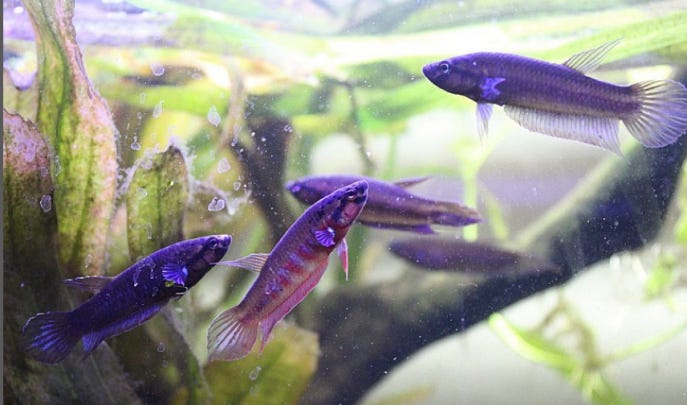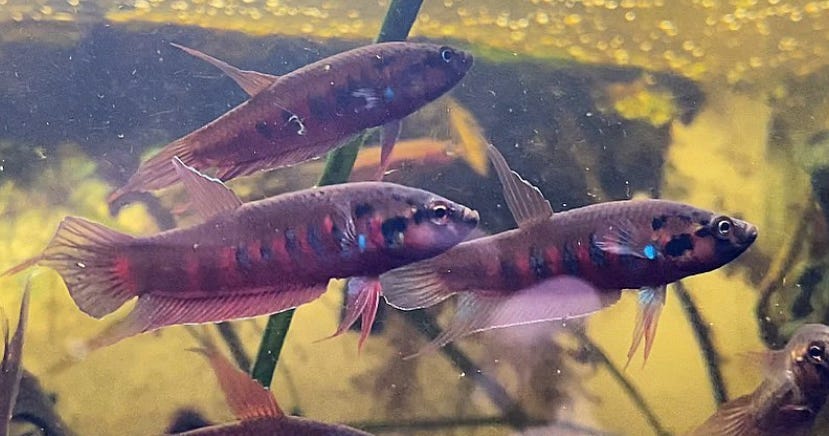Part of my betta-keeping journey took me in an unexpected direction— into the grasp of the elusive wild bettas. After several years of keeping domestic bettas, I felt I was ready for the challenge of keeping one of the many wild species of undomesticated bettas that exist. After much research and checking what was available in my area, I settled on the then-rare and mostly unknown Rubra betta.
Checkers, a male Rubra betta.
What are Rubra?
The wikipedia for them is a single sentence long under the name ‘Toba’ betta. The name Rubra comes from their species name, Rubra. They are native to peat swamps in Sumatra, Indonesia. They are a brown betta with the males displaying red and blue barring along their sides and red and blue on their fins. The face is spotted with dark scales. Females are brown with red and blue fins but lack the barring pattern of males. A single dark line present down their body may be present in their juvenile colors.
Rubra are chameleon fish. They shift color rapidly, changing their entire look within seconds. Even their eyes shift in pigments over time. In a group setting this can be used as a form of communication and displays of dominance.
Group shot of Rubra bettas
How I got started
They were advertised as a small, skittish mouth-brooder best kept in pairs (all wrong info). There was conflicting information online about the type of water parameters they preferred, the foods they can eat, the water temperature— everything was new and keepers were scrambling to figure out how best to keep these fish.
I ordered a pair of Rubra online that only later did I discover were wild-caught. At the time I was unaware of the term and what it meant— that these two bettas were caught in the wild and sold into the pet trade, put on a plane, and shipped to America. This is undersirable for many reasons— Rubra are an endangered species and removing these two from the wild population is at a detrement to the overall wild numbers of them. This also means that my two Rubra arrived pale, skinny, full of worms, and determened to starve to death. These things are common in wild caught bettas and often the hardest part of adjusting them to aquarium life is introducing them to new foods to eat. Some species are quite famous for this and will food-strike to death. This was my main worry after starting them on a dewormer. I named the pair Max and Ruby and got to work.
Since rubra-keeping was still in it’s beginning stages, I experimented a lot. I had the freedom to try different things, and I quickly started hitting positive milestones. First meals. First tank setups. I even introduced them to each other once I felt they were healthy enough for a meeting, and imagine my surprise when they began to show breeding behavior within the first twenty seconds of seeing each other. This incredible pattern would repeat itself throughout all Rubra I have kept. As it turns out, they are remarkably easy to breed under the right conditions.
Ruby, a female, at 2 years old then again at 4 years old.
Keeping Rubra
For the tanks I used a 2.5 for quarantines, 5 gallons for single bettas, and moved up to a 50 gallon for a group of 35 adults. These, as we now know, are a great communal species of betta and one of the few who do better in groups as opposed to alone. I kept slightly less males than females but even an all-male group can be kept without issue.
I’ve kept these bettas in a wide variety of water parameters. Hard water, soft water, high iron water. I even kept them in a trashcan for a week while on a cross-country move (and yes, they bred inside the trashcan). The thing is, while the water must be clean and cycled and heated to 80 degrees, they thrive in a huge range of parameters. There’s just two things they for sure get picky about.
Tannins and acidity. They like slightly acidic water with heavy tannins. Think like a peat swamp. They will not breed without tannins nor will they fully color up without them. Tannins are the magic ingredient to keeping Rubra bettas. I make my own out of oak leaves, acorn caps, and twigs boiled on a stove but with the advancement of wild-type keeping there’s tons of products available to add tannins to your water.
I keep them in densely planted swamp tanks with a sandy leaf litter floor. They seem to enjoy this environment the best but can be kept on gravel.
They will eat everything. I have not found a food they don’t like.
Unlike other wilds, which can be fragile disease-magnets, Rubra are tanks. Nothing kills them. I’ve never suffered a serious disease outbreak. Their lifespan online is advertised as 2-3 years, but mine are rapidly approaching 5 years old and are still going strong. The only thing to look out for is their love of jumping out of tanks. I’ve had them clear 15 vertical inches before. Lids are a necessity.
Benny and his sons Reckless and Brick on patrol together.
Breeding
These are a mouthbrooding betta. Unlike domestics there is no flaring, no bubblenesting. Instead, it is the female betta who, when ready to breed, will seek out and choose a male. Since I rapidly moved to keeping these betta in a communal group, the complex nature of their courtship became quickly apparent. The female will choose her male, chose a quiet, secluded spot, and engage in a dance to broadcast her interest. if the male also responds with this dance, courtship will begin. Rubra breed similar to bettas, with the male and female preforming a wrapping maneuver to fertilize the eggs. The difference is that as the eggs are laid, while the female is in her egg-trance, the male will gather them up and hold them in his mouth. This act can take several hours until the female is finished spawning. Afterwards, the male will go off food and hold the eggs in his mouth for about 17 days. When they fry are developed, he’ll spit them out. The fry are born as small, almost microscopic spines with eyes at one end. They are mostly eyes and mouth at this stage, but they are free-swimming and must take freshly hatched BBS at once. Spawn sizes can vary. Small batches might number less than ten and larger batches over thirty. The males may also be triggered into swallowing their eggs, mainly from stress, poor water conditions, disease, or New-Dad syndrome where they fail to carry simply because they’re first timers who are figuring things out.
The fry must be fed every day with live, small living foods like baby brine shrimp for the first several weeks, before moving up to ground frozen foods, and finally pellets. Unlike adults, who are trashcan bettas that will gladly eat literally anything, the fry are delicate and easily susceptible to poor water conditions. They are also susceptible to diseases like protozoans and require extremely accurate care to prevent stunting. 100% water changes must be done often to keep parameters pristine.
They grow slower than domestics, reaching a sexable size at around 6 months of age.








Wow… this was so interesting. I am impressed with how you self educated and then hit the ground running! Good Luck!